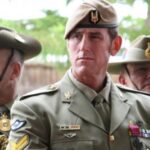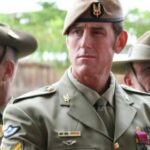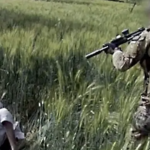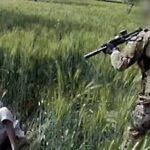Ben Roberts-Smith: Bully, Liar, War Criminal
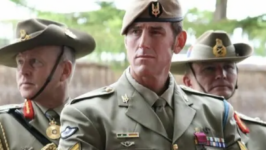
A judge of the Federal Court of Australia has found the media was truthful in describing our nation’s most decorated living soldier as a war criminal, after hearing extensive evidence from Australian soldiers and many other witnesses during a three-month defamation hearing.
Witnesses told the truth
Australia’s most decorated living soldier, Ben Roberts-Smith VC, has lost the defamation case he chose to bring against The Age, The Sydney Morning Herald and The Canberra Times, as well as several of their journalists, with Justice Anthony Besanko finding that the description of him as a ‘war criminal’ who perpetrated numerous atrocities including the murder of several civilians in Afghanistan is truthful.
A disgrace to our nation
Mr Roberts-Smith brought the defamation claim in response to a string of articles which accused the soldier of war crimes, including handcuffing an elderly farmer named Alican – a husband and father – and kicking him off a cliff.
Alican was severely wounded when he hit the ground below the cliff, before Roberts-Smith and two fellow SAS soldiers climbed down to where he was writhing in pain and shot him dead – a cold-blooded execution.
The reason for the horrific murder? The farmer smiled at Roberts-Smith.
Roberts-Smith was also found to have dropped a detainee to the ground before shooting him in the back in what was called an “exhibition execution”, executing an unarmed detainees who had a prosthetic leg before him and his colleagues drank alcohol from the “trophy”, and directing a junior soldier to execute another detainee in an initiation ritual known as “blooding”.
The abhorrent crimes were reported by brave fellow Australian soldiers who were appalled by their superior’s conduct.
Thirty-two Australian soldiers, as well as several civilian eyewitnesses from Afghanistan, testified against Roberts-Smith during the twenty-two week trial, which is estimated to have cost $35 million in legal fees. Several of the soldiers served alongside Roberts-Smith and witnessed his war crimes.
Equally brave were the actions of military lawyer David McBride who, after bringing reports of war crimes committed by Australian soldiers in Afghanistan to the attention of his superiors (who did nothing about them) leaked the reports to the media in what became known as the Afghan files.
For his efforts, Mr McBride was, and continues to be, criminally prosecuted over the leak, and is set to face a trial and the potential of spending years behind bars.
The conduct of people like Mr Roberts-Smith’s – murdering civilians and detainees in nations such as Iraq and Afghanistan that many believe the United States and its allies, including Australia, were never legally justified in invading n the first place – can give some insight into why nations such as ours have become targets of terrorism offences – offences some see as retribution for acts committed against them by occupiers.
All claims dismissed
Mr Roberts-Smith also testified during the defamation trial, and the presiding judge ultimately found that the media had discharged its legal onus of proving the defence of truth on the balance of probabilities in respect of all claims; in other words, that all of the allegedly defamatory imputations contained in their publications were substantially truthful.
It is clear the court believed the testimony of the thirty-two soldiers who testified against Mr Roberts-Smith, and did not believe the Victoria Cross recipient, who was in Bali at the time of the judgment despite reportedly attending court on almost every day of the twenty-two week hearing.
Roberts-Smith will not be out-of-pocket as his legal expenses have been bankrolled by the owner of Seven West Media, Kerry Stokes – something which Roberts-Smith gloated about in a number of communications.
Bully, liar, war criminal
Roberts-Smith’s crimes were not perpetrated during the ‘heat of battle’ or in the ‘fog of war’, but were cold, calculated abhorrent acts committed by a man fairly described by Channel Nine journalist Nick McKenzie outside court as a “bully”, “liar” and “war criminal”.
His deplorable conduct also extended beyond the battlefield, with the reports including assertions he persuaded a fellow soldier to lie to authorities on his behalf in an attempt to cover-up his crimes.
Many hope the evidence given during the proceedings will inform a criminal prosecution against Roberts-Smith for international war crimes including wilful killing, torture and inhumane treatment.
The former offence carries a maximum penalty of life in prison, while each of the latter carry 25 years.
It is also hoped the saga will lead to improvements in the culture within the Australian Defence Force – a culture which the Brereton Report found systematically tolerated and even encouraged abhorrent human rights abuses that contravened Australia’s obligations under the Geneva Conventions in the most brazen and fundamental ways.
The judgment
The Federal Court released the following summary judgment in the ‘public interest’, and is expected to publish a full judgment Monday:
“Mr Ben Roberts-Smith VC MG has brought three actions in this Court for defamation. The first action is brought against Fairfax Media Publications Pty Limited, Mr Nick McKenzie, Mr Chris Masters and Mr David Wroe. The second action is brought against The Age Company Pty Limited, Mr Nick McKenzie, Mr Chris Masters and Mr David Wroe. The third action is brought against The Federal Capital Press of Australia Pty Limited, Mr Nick McKenzie, Mr Chris Masters and Mr David Wroe. The three proceedings have been heard together.
There are a total of 16 matters complained of. The publications appeared in newspapers and were made available online. The articles may be divided into three groups.
The first group of articles were published on 9 and 8 June 2018. The applicant claimed that the following imputations were conveyed or communicated by the Group 1 articles:
(1) The applicant while a member of the SASR, murdered an unarmed and defenceless Afghan civilian, by kicking him off a cliff and procuring the soldiers under his command to shoot him (Imputation 1).
(2) The applicant broke the moral and legal rules of military engagement and is therefore a criminal (Imputation 2).
(3) The applicant disgraced his country Australia and the Australian army by his conduct as a member of the SASR in Afghanistan (Imputation 3).
The second group of articles were published on 10 and 9 June 2018. The applicant claimed that the following imputations were conveyed or communicated by the Group 2 articles:
(1) The applicant while a member of the SASR, committed murder by pressuring a newly deployed and inexperienced SASR soldier to execute an elderly, unarmed Afghan in order to “blood the rookie” (Imputation 4).
(2) The applicant while a member of the SASR, committed murder by machine gunning a man with a prosthetic leg (Imputation 5).
(3) The applicant while a member of the SASR, murdered an unarmed and defenceless Afghan civilian, by kicking him off a cliff and procuring the soldiers under his command to shoot him (Imputation 1).
(4) The applicant having committed murder by machine gunning a man in Afghanistan with a prosthetic leg, is so callous and inhumane that he took the prosthetic leg back to Australia and encouraged his soldiers to use it as a novelty beer drinking vessel (Imputation 6).
The applicant was not named in the Group 1 articles or the Group 2 articles. A soldier called “Leonidas” was referred to. By the end of the trial, there was no dispute about the identification of the applicant in the Group 1 and Group 2 articles.
The third group of articles were published on 11 and 10 August 2018. The applicant was named in these articles and there was never any identification issue. The applicant claimed that the following imputations were conveyed or communicated by the Group 3 articles:
(1) The applicant committed an act of domestic violence against a woman in the Hotel Realm in Canberra (Imputation 7).
(2) The applicant is a hypocrite who publicly supported Rosie Batty, a domestic violence campaigner, when in private he abused a woman (Imputation 8).
(3) The applicant as deputy commander of a 2009 SASR patrol, authorised the execution of an unarmed Afghan by a junior trooper in his patrol (Imputation 9).
(4) The applicant during the course of his 2010 deployment to Afghanistan, bashed an unarmed Afghan in the face with his fists and in the stomach with his knee and in so doing alarmed two patrol commanders to the extent that they ordered him to back off (Imputation 10).
(5) The applicant as patrol commander in 2012 authorised the assault of an unarmed Afghan, who was being held in custody and posed no threat (Imputation 11).
(6) The applicant engaged in a campaign of bullying against a small and quiet soldier called Trooper M which included threats of violence (Imputation 12).
(7) The applicant threatened to report Trooper J to the International Criminal Court for firing at civilians, unless he provided an account of a friendly fire incident that was consistent with the applicant’s (Imputation 13).
(8) The applicant assaulted an unarmed Afghan in 2012 (Imputation 14).
The first issue in the proceedings is whether the imputations alleged by the applicant were conveyed or communicated by the articles. There was no dispute between the parties that the Group 1 articles conveyed or communicated Imputations 1, 2 and 3. There was no dispute between the parties that the Group 2 articles conveyed or communicated Imputation 1. There was a dispute between the parties as to whether the Group 2 articles conveyed or communicated Imputations 4, 5 and 6. I find that those imputations were conveyed by the Group 2 articles. There was also a dispute between the parties as to whether the Group 3 articles conveyed or communicated any of Imputations 7 to 14 inclusive. Subject to one matter concerning Imputation 9, I find that each of those imputations are conveyed or communicated by the Group 3 articles. The one qualification is that in the case of Imputation 9, I find that the imputation which was conveyed or communicated was as follows:
The applicant as deputy commander of a 2009 SASR patrol, acquiesced in the execution of an unarmed Afghan by a junior trooper in his patrol.
The Defences of the respondents in each proceeding are similar. They are justification or substantial truth (s 25 of the Defamation Act 2005 (NSW)) and contextual truth (s 26 of the Defamation Act). With respect to the defence of justification or substantial truth, the respondents’ Particulars of Truth are very substantial. They consist of in the order of 150 paragraphs.
With respect to the defence of contextual truth, the respondents in each action plead that Imputations 2 and 3 as pleaded by the applicant in relation to the Group 1 articles, arise as contextual imputations in the case of the Group 2 and Group 3 articles and that they are substantially true. If that is so, they have a defence where the defamatory imputations pleaded by the applicant (to the extent that they are not shown to be substantially true) do not further harm the reputation of the applicant because of the substantial truth of the contextual imputations.
In the alternative to these two defences, the respondents plead a number of matters which they contend mitigate damages.
The most serious allegations made in the Particulars of Truth are that the applicant murdered or was complicit in and responsible for the murder of Afghan males who were under control or containment. That allegation is made in relation to two Afghan males on a mission to Whiskey 108 on 12 April 2009, one Afghan male on a mission to Darwan on 11 September 2012, one Afghan male on a mission to Chinartu on 12 October 2012, one Afghan male on a mission to Syahchow on 20 October 2012, and one Afghan male on a mission to Fasil on 5 November 2012.
The Particulars of Truth also contain a serious allegation that the applicant assaulted Person 17 on or about 28 March 2018 in a hotel room in Canberra.
In addition, there are allegations against the applicant of assault of Afghan males under detention, bullying of an Australian soldier and making a threat to another Australian soldier.
The trial was interrupted because of the effects of the COVID-19 pandemic and, thereafter, occupied a substantial period of time. A number of SASR soldiers gave evidence. Their identity was protected and, in the case of their evidence in open Court, they were heard but not seen. There were also a number of Sensitive Documents and Sensitive Information and that necessitated the Court sitting in closed sessions. That was done pursuant to orders I made under the National Security Information (Criminal and Civil Proceedings) Act 2004 (Cth) and, speaking broadly, related to national security concerns. I will publish what I call open Court reasons. They are lengthy. There are also closed Court reasons to be provided to a limited number of persons in closed Court. I can indicate that the closed Court reasons are in the order of 50 pages and that they address, in some detail, aspects of the closed Court evidence relevant to the missions to W108, Darwan and Chinartu. There is a fairly short reference to the mission to Fasil. There are very short references to the alleged bullying of Person 1, the alleged unlawful assaults on PUCs, and the intimidation of witnesses, collusion and contamination of witnesses, concealment of relevant evidence and material, and lies and the alleged separation of the applicant and Ms Roberts. I will be asking the parties and the Commonwealth to consider carefully the closed Court reasons and advise whether there are aspects of those reasons which may be published on an unrestricted basis as redacted closed Court reasons.
It is not practical for me to summarise all of the findings and conclusions as set out in the reasons. The following are the major conclusions.
(1) The applicant’s conduct and actions on the mission to W108 as found means that the respondents have established the substantial truth of Imputations 2, 3, 4, 5, 6 and 9;
(2) The applicant’s conduct and actions on the mission to Darwan as found means that the respondents have established the substantial truth of Imputations 1, 2 and 3;
(3) The applicant’s conduct and actions on the mission to Chinartu as found means that the respondents have established the substantial truth of Imputations 2 and 3;
(4) The respondents have not established the Particulars of Truth with respect to the mission to Syahchow on 20 October 2012;
(5) The respondents have not established the Particulars of Truth with respect to the mission to Fasil on 5 November 2012;
(6) With respect to the alleged bullying of Person 1, the respondents have established the substantial truth of Imputation 12;
(7) With respect to the alleged unlawful assaults on PUCs, and this relates to Imputations 10, 11 and 14, the respondents have established the substantial truth of those imputations;
(8) With respect to the alleged act of domestic violence and Imputations 7 and 8, I am not satisfied that Person 17’s evidence is sufficiently reliable to form the basis of a finding that the assault occurred and that Imputations 7 and 8 are substantially true. However, I consider that the respondents have made out the defence of contextual truth (s 26) with respect to those imputations.
(9) With respect to the alleged threat to “Trooper J” and Imputation 13, I am not satisfied that the evidence is sufficiently clear to support a threat of the type advanced by the respondents and that they have shown the imputation to be substantially true. However, I am satisfied that the respondents have made out a defence of contextual truth (s 26) with respect to that imputation.
In light of my conclusions, each proceeding must be dismissed. At this point, I would ordinarily publish my reasons, but I understand that the Commonwealth has an application to make in that regard.
I will shortly move into closed Court to publish my closed Court reasons. As I have said, I will ask the parties and the Commonwealth to consider carefully whether there are aspects of the closed Court reasons which might be published on an unrestricted basis.
JUSTICE ANTHONY BESANKO
1 JUNE 2023”

